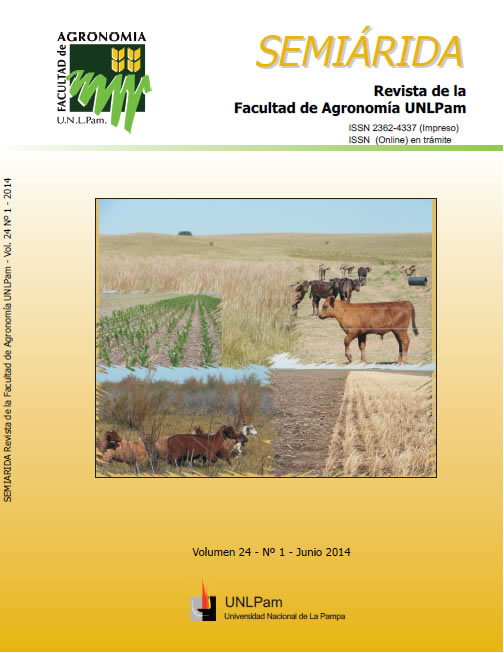Ver ítem
- xmlui.general.dspace_homeCentros Regionales y EEAsCentro Regional La Pampa - San LuisEEA AnguilArtículos científicosxmlui.ArtifactBrowser.ItemViewer.trail
- Inicio
- Centros Regionales y EEAs
- Centro Regional La Pampa - San Luis
- EEA Anguil
- Artículos científicos
- Ver ítem
Ensayo comparativo de rendimiento de cinco cultivares bienales de zanahoria (Daucus carota l.) en la Región Semiárida Pampeana, bajo riego por goteo = Performance comparative test for five biennial cultivars of carrot (Daucus carota l.) In the Pampean Semiarid Region, under drip irrigation
Resumen
El objetivo del trabajo fue evaluar el rendimiento y la calidad de las raíces de cinco cultivares
bienales de zanahoria en la Región Semiárida Pampeana: Natasha, Supreme, Beatriz INTA,
y dos líneas de mejoramiento del INTA Línea1 y Línea2. El ensayo se realizó en la EEA INTA
Anguil. El diseño fue en bloques completos al azar con cuatro repeticiones. La parcela experimental
fue de 1,5 m2. La siembra se realizó a chorrillo el 29/09/2012, luego se
[ver mas...]
El objetivo del trabajo fue evaluar el rendimiento y la calidad de las raíces de cinco cultivares
bienales de zanahoria en la Región Semiárida Pampeana: Natasha, Supreme, Beatriz INTA,
y dos líneas de mejoramiento del INTA Línea1 y Línea2. El ensayo se realizó en la EEA INTA
Anguil. El diseño fue en bloques completos al azar con cuatro repeticiones. La parcela experimental
fue de 1,5 m2. La siembra se realizó a chorrillo el 29/09/2012, luego se efectuó raleo
de plantas. El riego fue por goteo. Se incorporó materia orgánica y se fertilizó con urea (75
Kg de Nitrógeno.ha-1). El control de malezas fue manual. Se cosechó el 24/01/2013. Se evaluó
rendimiento y calidad y se realizó panel de degustación. La Línea1 alcanzó mayor rendimiento
total y comercial, sin diferenciarse estadísticamente de Natasha, Supreme y Beatriz.
El mayor porcentaje de descarte fue por raíces fuera de tamaño, siendo la Línea2 la más
afectada, y por raíces deformadas. No se observaron plantas con floración prematura ni raíces
enfermas. Natasha y Beatriz fueron las más aceptadas por su sabor dulce, mientras que por
color naranja intenso se eligió a Natasha y Línea2. Se puede concluir que en la Región Semiárida
Pampeana el cultivo de zanahorias bienales es factible de realizar obteniéndose rendimientos
y calidades aceptables.
[Cerrar]
The objective of this work was to test root production and quality of biennial cultivars “Natasha”,
“Supreme”, “Beatriz INTA” and INTA breeding lines “1” and “2”, in the semiarid region
of La Pampa province, Argentina. The experiment was carried out at the Agricultural Research
Station of Anguil INTA, using a randomised complete block design with four replications and
test plots of 1,5 m2 size. The seeding was done by steady flow in lines separated 10
[ver mas...]
The objective of this work was to test root production and quality of biennial cultivars “Natasha”,
“Supreme”, “Beatriz INTA” and INTA breeding lines “1” and “2”, in the semiarid region
of La Pampa province, Argentina. The experiment was carried out at the Agricultural Research
Station of Anguil INTA, using a randomised complete block design with four replications and
test plots of 1,5 m2 size. The seeding was done by steady flow in lines separated 10 cm from
each other, during the end of September 2012. The crop was subjected to seedling thinning
and watering by a drip irrigation system. Organic fertilizer was applied to soil together with 75
kg per hectare of urea Nitrogen, and weeds were controlled manually. Root harvest was done
during the last day of January 2013. Evaluation of harvested roots was assessed for yield and
morphological attributes of quality, as well as sensory cues tested by a panel of outsiders. Line
1 INTA showed the highest total and commercial yield, but without a statistical difference from
Natasha, Supreme and Beatriz INTA cultivars. The highest discard proportion was for shortcomings
such as roots falling outside commercial size, with Line 2 INTA as the most affected,
and misshapen roots. No plants were observed showing premature flowering or diseased roots.
Natasha and Beatriz cultivars had the highest acceptance because of root sweeter taste, although
the former and Line 2 INTA were more preferred due to their intense orange colour.
[Cerrar]

Fuente
Semiárida : Revista de la Facultad de Agronomía, Universidad Nacional de La Pampa 24 (1): 39-54. (2014)
Fecha
2014
Editorial
Facultad de Agronomía, UNLPam
ISSN
2362-4337
2408-4077 (Online)
2408-4077 (Online)
Formato
pdf
Tipo de documento
artículo
Palabras Claves
Derechos de acceso
Abierto
 Excepto donde se diga explicitamente, este item se publica bajo la siguiente descripción: Creative Commons Attribution-NonCommercial-ShareAlike 2.5 Unported (CC BY-NC-SA 2.5)
Excepto donde se diga explicitamente, este item se publica bajo la siguiente descripción: Creative Commons Attribution-NonCommercial-ShareAlike 2.5 Unported (CC BY-NC-SA 2.5)


